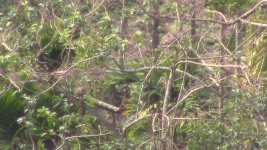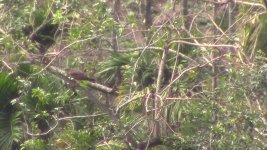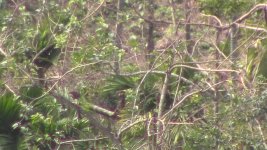-
Welcome to BirdForum, the internet's largest birding community with thousands of members from all over the world. The forums are dedicated to wild birds, birding, binoculars and equipment and all that goes with it.
Please register for an account to take part in the discussions in the forum, post your pictures in the gallery and more.
You are using an out of date browser. It may not display this or other websites correctly.
You should upgrade or use an alternative browser.
You should upgrade or use an alternative browser.
Unknown Raptor ID help please, Hainan, China (1 Viewer)
- Thread starter Hainan on the fly
- Start date
More options
Who Replied?Deb Burhinus
Used to be well known! 😎

I’m inclined to agree - it looks too longed winged for any of the accipiter possibilities inc Crested Goshawk.
Hainan on the fly
Well-known member
Looks like a Grey-faced Buzzard
Thanks! I think you've got it!
Hainan on the fly
Well-known member
I’m inclined to agree - it looks too longed winged for any of the accipiter possibilities inc Crested Goshawk.
Thanks, Deb. I'm new to this but I was pretty sure it wasn't any of the accipiter I'm used to seeing when I had the binoculars on it. I wasn't sure what I was looking at but I was pretty sure what it wasn't. I guess that means I'm making a little progress. I did look at Oriental Honey-buzzard which was quickly ruled out on plumage but missed Gray-faced buzzard as it is a pretty rare sighting here. Let me make sure I have something correct if you don't mind entertaining a question. The wings are way too long, right? The wing tips on this bird nearly reach the end of the tail while on accipiters they are only about 1/3 of the way down the tail. Am I correct in this statement?
Thanks so much for your help!
Brian
Deb Burhinus
Used to be well known! 😎

Thanks, Deb... Let me make sure I have something correct if you don't mind entertaining a question. The wings are way too long, right? The wing tips on this bird nearly reach the end of the tail while on accipiters they are only about 1/3 of the way down the tail. Am I correct in this statement?
Brian
Hi Brian
Comparing this OP raptor to other small/medium raptors you might consider, the wingtips come nearly to the tip of the tail. Generally (very!) speaking, it helps when seeing distant/poor views of raptors to first ascertain the genus - which can then help narrowing down the species. Falcons, buzzards and accipiters generally have particular structures reflecting their hunting techniques.
So just as an example, relevant to this incidence, Japanese Sparrowhawk, Shikra, Besra, Crested Goshawk are all accipiters which typically have short rounded wings and proportionately long tails, which when perched, show folded wings falling far short of the tail tip (as you say, often about 1:3 or shorter ratio): Accipiters are generally stealth hunters and the long tail particularly allows them good manoeuvrability through wooded/forested areas chasing prey:
http://orientalbirdimages.org/search.php?Bird_Image_ID=102840&Bird_ID=905&Bird_Family_ID=&Location=
http://orientalbirdimages.org/search.php?Bird_Image_ID=171862&Bird_ID=902&Bird_Family_ID=&Location=
http://orientalbirdimages.org/search.php?Bird_Image_ID=189781&Bird_ID=852&Bird_Family_ID=&Location=
and Crested Goshawk, note the tail pattern and large size/bulky shape but compare wing :->tail length to your bird
http://orientalbirdimages.org/search.php?Bird_Image_ID=187284&Bird_ID=850&Bird_Family_ID=&Location=
Falcons eg. Peregrine, Oriental Hobby, kestrel sp etc have proportionately long pointed wings (which tend to reach from 2:3->tip of the tail when perched) - their particular wing shape gives them good aerial manoeuvrability for chasing and stooping on prey in flight.
http://orientalbirdimages.org/search.php?Bird_Image_ID=190497&Bird_ID=1056&Bird_Family_ID=&Location=
http://orientalbirdimages.org/search.php?Bird_Image_ID=153040&Bird_ID=1048&Bird_Family_ID=&Location=
(Common Kestrel have slightly shorter wings than Lesser Kestrel)
http://orientalbirdimages.org/search.php?Bird_Image_ID=186875&Bird_ID=1054&Bird_Family_ID=&Location=
http://orientalbirdimages.org/search.php?Bird_Image_ID=186292&Bird_ID=1053&Bird_Family_ID=&Location=
Finally buzzards (inc the Honey Buzzards) generally have long, broad wings and relatively short tails (cf to accipiters) so their wings too reach near the tail tip when perched. The broad long wings (together with long primary ‘fingers’ which help prevent stalling) make them particularly adapted to slow flight and soaring the thermals to search for ground prey in more open habitat.
http://orientalbirdimages.org/search.php?Bird_Image_ID=167156&Bird_ID=913&Bird_Family_ID=&Location=
http://orientalbirdimages.org/search.php?Bird_Image_ID=187916&Bird_ID=913&Bird_Family_ID=&Location=
Grey-faced Buzzard
http://orientalbirdimages.org/search.php?Bird_Image_ID=164623&Bird_ID=915&Bird_Family_ID=&Location=
(The Grey-faced Buzzard is actually quite adaptive to mixed foraging habitats and uses mixed techniques (including perch and ambush when in more dense habitat) and has slim wings and narrow hands in flight - (perhaps more reminiscent of a Goshawk sp than a ‘buzzard’ ) - giving it the best of both worlds)
http://orientalbirdimages.org/search.php?Bird_Image_ID=82407&Bird_ID=915&Bird_Family_ID=&Location=
Anyway, hope that helps
Last edited:
johnallcock
Well-known member
Thanks, Deb. I'm new to this but I was pretty sure it wasn't any of the accipiter I'm used to seeing when I had the binoculars on it. I wasn't sure what I was looking at but I was pretty sure what it wasn't. I guess that means I'm making a little progress. I did look at Oriental Honey-buzzard which was quickly ruled out on plumage but missed Gray-faced buzzard as it is a pretty rare sighting here. Let me make sure I have something correct if you don't mind entertaining a question. The wings are way too long, right? The wing tips on this bird nearly reach the end of the tail while on accipiters they are only about 1/3 of the way down the tail. Am I correct in this statement?
Thanks so much for your help!
Brian
I agree with ID of this bird as Grey-faced Buzzard.
I get the impression that there have been a lot more reports of Grey-faced Buzzard in Hong Kong this autumn than in a normal year (I haven't seen any though :-C). They're usually more common in spring.
We've had a prolonged spell of strong northeasterly winds this year and a series of tropical storms that have tracked across the South China Sea to Hainan and Vietnam. I wonder if GfB migrating from Taiwan to the Philippines have avoided the crossing or have been blown off course and ended up on the mainland instead?
Hainan on the fly
Well-known member
Hi Brian
Comparing this OP raptor to other small/medium raptors you might consider, the wingtips come nearly to the tip of the tail. Generally (very!) speaking, it helps when seeing distant/poor views of raptors to first ascertain the genus - which can then help narrowing down the species. Falcons, buzzards and accipiters generally have particular structures reflecting their hunting techniques.
So just as an example, relevant to this incidence, Japanese Sparrowhawk, Shikra, Besra, Crested Goshawk are all accipiters which typically have short rounded wings and proportionately long tails, which when perched, show folded wings falling far short of the tail tip (as you say, often about 1:3 or shorter ratio): Accipiters are generally stealth hunters and the long tail particularly allows them good manoeuvrability through wooded/forested areas chasing prey:
http://orientalbirdimages.org/search.php?Bird_Image_ID=102840&Bird_ID=905&Bird_Family_ID=&Location=
http://orientalbirdimages.org/search.php?Bird_Image_ID=171862&Bird_ID=902&Bird_Family_ID=&Location=
http://orientalbirdimages.org/search.php?Bird_Image_ID=189781&Bird_ID=852&Bird_Family_ID=&Location=
and Crested Goshawk, note the tail pattern and large size/bulky shape but compare wing :->tail length to your bird
http://orientalbirdimages.org/search.php?Bird_Image_ID=187284&Bird_ID=850&Bird_Family_ID=&Location=
Falcons eg. Peregrine, Oriental Hobby, kestrel sp etc have proportionately long pointed wings (which tend to reach from 2:3->tip of the tail when perched) - their particular wing shape gives them good aerial manoeuvrability for chasing and stooping on prey in flight.
http://orientalbirdimages.org/search.php?Bird_Image_ID=190497&Bird_ID=1056&Bird_Family_ID=&Location=
http://orientalbirdimages.org/search.php?Bird_Image_ID=153040&Bird_ID=1048&Bird_Family_ID=&Location=
(Common Kestrel have slightly shorter wings than Lesser Kestrel)
http://orientalbirdimages.org/search.php?Bird_Image_ID=186875&Bird_ID=1054&Bird_Family_ID=&Location=
http://orientalbirdimages.org/search.php?Bird_Image_ID=186292&Bird_ID=1053&Bird_Family_ID=&Location=
Finally buzzards (inc the Honey Buzzards) generally have long, broad wings and relatively short tails (cf to accipiters) so their wings too reach near the tail tip when perched. The broad long wings (together with long primary ‘fingers’ which help prevent stalling) make them particularly adapted to slow flight and soaring the thermals to search for ground prey in more open habitat.
http://orientalbirdimages.org/search.php?Bird_Image_ID=167156&Bird_ID=913&Bird_Family_ID=&Location=
http://orientalbirdimages.org/search.php?Bird_Image_ID=187916&Bird_ID=913&Bird_Family_ID=&Location=
Grey-faced Buzzard
http://orientalbirdimages.org/search.php?Bird_Image_ID=164623&Bird_ID=915&Bird_Family_ID=&Location=
(The Grey-faced Buzzard is actually quite adaptive to mixed foraging habitats and uses mixed techniques (including perch and ambush when in more dense habitat) and has slim wings and narrow hands in flight - (perhaps more reminiscent of a Goshawk sp than a ‘buzzard’ ) - giving it the best of both worlds)
http://orientalbirdimages.org/search.php?Bird_Image_ID=82407&Bird_ID=915&Bird_Family_ID=&Location=
Anyway, hope that helps
Wow!! This information is so incredibly helpful and interesting! I really appreciate you taking the time.
Thanks so much!
Brian
Hainan on the fly
Well-known member
I agree with ID of this bird as Grey-faced Buzzard.
I get the impression that there have been a lot more reports of Grey-faced Buzzard in Hong Kong this autumn than in a normal year (I haven't seen any though :-C). They're usually more common in spring.
We've had a prolonged spell of strong northeasterly winds this year and a series of tropical storms that have tracked across the South China Sea to Hainan and Vietnam. I wonder if GfB migrating from Taiwan to the Philippines have avoided the crossing or have been blown off course and ended up on the mainland instead?
That it is an interesting observation, John. Thanks for sharing :t:
Deb Burhinus
Used to be well known! 😎

Wow!! This information is so incredibly helpful and interesting! I really appreciate you taking the time.
Thanks so much!
Brian
You are absolutely welcome Brian :t:
Users who are viewing this thread
Total: 2 (members: 0, guests: 2)







